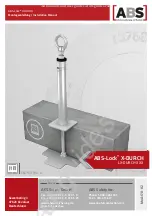
CRIRES User Manual
Doc. Number: ESO-254264
Doc. Version: P109.4
Issued on:
2021-12-01
Page:
62 of 99
Document Classification: ESO Internal Use [Confidential for Non-ESO Staff]
We recommend to users who wish to specify the telescope guide star to use the ‘ObsPrep’
tab when editing an OB in the P2 tool. ‘ObsPrep’ will allow the user to interactively select a
telescope guide star and will automatically update the coordinate values in the OB.
6.3.3 Slit Viewer Guide Star (SVGS) details
·
Magnitude of Slit Viewer Guide star
(TSF:
SEQ.SVGS.HMAG
): Uses need to specify the H-
band magnitude of the SV guide star to allow for the correct setting of the integration time
of the slit viewer camera.
·
RA/DEC offset between target and SV guide star
(TSF:
TEL.TARG.OFFSETALPHA,
TEL.TARG.OFFSETDELTA
) correspond to the offsets,
in units of arcsec
(mind the difference
between sec and arcsec in RA), necessary to move from the target to the SVGS.
If the
SVGS is the target, then these values must be left unchanged at 0.
Let α(SVGS) and δ(SVGS) be the coordinates of the SVGS, then he sign convention is as
follows:
TEL.TARG.ALPHA + TEL.TARG.OFFSETALPHA
= α(SVGS)
TEL.TARG.DELTA + TEL.TARG.OFFSETDELTA
= δ(SVGS)
In other words,
TEL.TARG.OFFSETALPHA
and
TEL.TARG.OFFSETDELTA
are positive if the SVGS
is located to the East and North of the target. Note that during the OB execution the SVGS
must be kept always within the SV field of view (see Figure 27). These parameters must be
provided if no differential tracking is needed.
We recommend using the ‘ObsPrep’ tool in P2 when selecting an SV guide star. This tool
allows the user to interactively select a telescope guide star, and ‘ObsPrep’ will
automatically update the coordinate values in the acquisition template.
·
Use the last sky measurement for the SV
(TSF:
SEQ.SV.USELASTSKY
): if one observes a
faint target or if the SVGS is not particularly bright (i.e., H>12), a new sky exposure should
be obtained. This is the default value for this keyword (
SEQ.SV.USELASTSKY
=F). When
observing brighter targets, however, one can use the last sky measurement
(
SEQ.SV.USELASTSKY
=T).
·
RA/DEC offset to sky
(TSF:
TEL.SKY.OFFSETALPHA, TEL.SKY.OFFSETDELTA
) are only
relevant if
SEQ.SV.USELASTSKY
= F. By default, the sky exposures are taken 30‘’ in RA and
DEC from the science target position. In crowded fields however, the RA/DEC offset might
need to be fine-tuned to prevent from acquiring the sky exposure in a region highly
contaminated by other sources. The convention for these RA, DEC offsets is:
TEL.SKY.OFFSETALPHA
= α
SKY
- α(target)
TEL.SKY.OFFSETDELTA
= δ
SKY
- δ(target)
















































